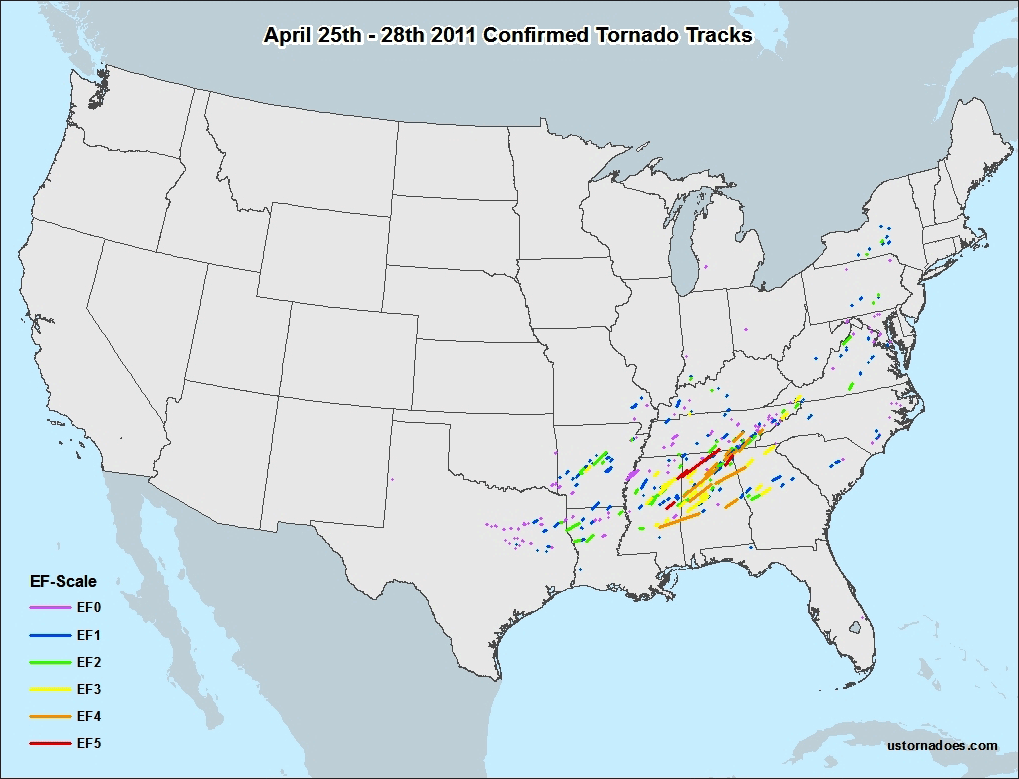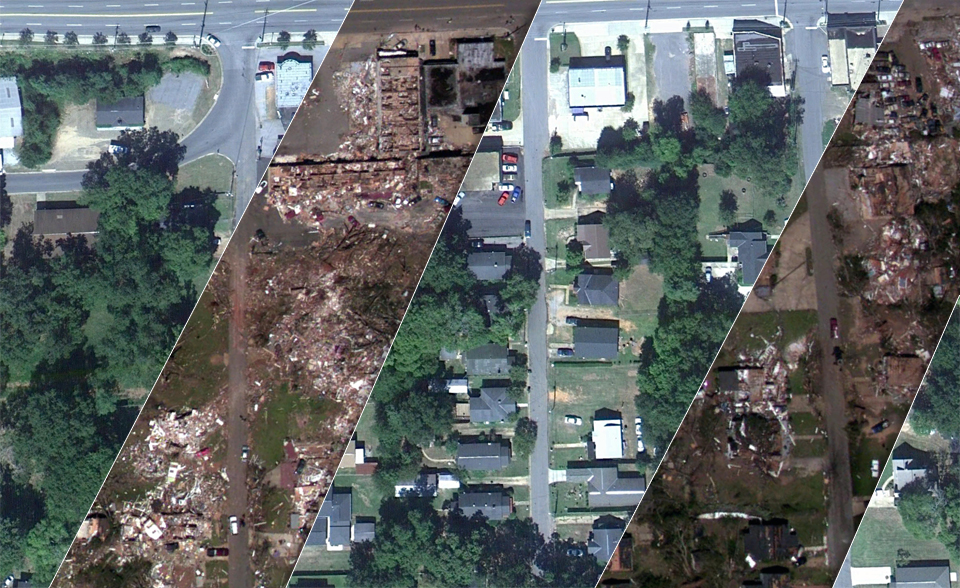
What is a Tornado Outbreak?
A tornado outbreak is the occurrence of multiple tornadoes spawned by the same synoptic scale weather system within a short period of time. Although tornadoes are deadly by themselves, they are not nearly as dangerous as when there are multiple tornadoes at once spreading across multiple vast areas. For it to be considered a tornado outbreak, tornadoes must spawn within 6 hours of each other within the same region. According to the NWS (National Weather Service) There is a 62% increase in damages and a 23% increase in casualties for every tornado spawned.What is known, to be the worst Tornado Outbreak?
The worst tornado outbreak occurred during April 25-28th in 2011. This surpassed the last most deadly outbreak occurring in 1978 in which 148 tornadoes were counted. During the warm spring of 20ll, the worlds largest recorded tornado outbreak occurred causing pandemonium across southern and mid-western parts of the United States. On April 25th through April 28th, there were 324 confirmed tornadoes which caused well over $11 billion dollars in damages. This disaster took its place in being the worlds most costly tornado disaster as well as one of the countries most costly natural disasters. Along with being the most costly tornado disaster, this also became one of the leading tornado disasters in human casualties killing 348 people.
Who was affected?
21 states were affected across the United States. Mostly occurring within the Southern, Mid-Western, or North-Eastern regions. Mississippi and Alabama were hit the hardest. Mississippi and Alabama spent Millions in rebuilding their beloved towns. Each day that the outbreak continued, more and more tornadoes spawned in a pattern like formation. This pattern like formation became known as "Pulgas o ver", meaning flea or see. To the locals, this meant leave while you can or watch your possessions disappear.
What happened each day?
April 25th
Beginning on April 25th, officials reported that there would be mild yet dangerous tornadoes through Arkansas and Tennessee for only a short amount of time. Little did they know, that cold air continued to blow from the north causing it to collide with the warm air from the gulf of mexico. The storms only grew larger and more air began to blow through. By the end of the day, meteorologists realized that they had a crisis on their hands. They alerted over 500 towns before enough tornadoes formed to cause destruction. Unfortunately tornadoes are unpredictable and change direction at a moments notice. This caused for more unpredictable destruction.
April 26th
On April 26th, a server weather alert was issued across the south/eastern areas of the United States. Areas such as Interstate 30 as well as the lower great lakes and many other surrounding areas were closed and or warned. Northern areas began to attract tornadoes causing server flooding around the great lakes. By this time, tornadoes were not the only source of destruction. Civilians had to be cautious about tornadoes, flooding, and storms.
April 27th
On April 27th, across the southern United States, there was a 45% chance that at any given time of day, you would either have a tornado or a server wind storm. Alabama and Tennessee were facing large power outages and water contamination. Tornadoes spread to interstate 81 and eventually began to affect areas in Maryland, Pennsylvania, and even New York. Over 240 tornado reports were given on this day alone. 95% of deaths happened on this day.
April 28th
On the final day, April 28th tornado watches were given along the Atlantic coast from New York to Florida. The tornado count was decreasing significantly. The last tornado hit North Carolina in the late afternoon. By this time all tornadoes became weak and flash flooding began to seep away.
| Date | Total | EF0 | EF1 | EF2 | EF3 | EF4 | EF5 | Deaths | Injuries |
|---|---|---|---|---|---|---|---|---|---|
| April 25 | 42 | 17 | 20 | 4 | 1 | 0 | 0 | 4 | -- |
| April 26 | 55 | 31 | 19 | 4 | 1 | 0 | 0 | 0 | -- |
| April 27 | 211 | 63* | 78 | 36 | 19 | 11 | 4 | 316 | 2000+ |
| April 28 | 47 | 18 | 23 | 5 | 1 | 0 | 0 | 3 | -- |
| Total | 355 | 129* | 140 | 49 | 22 | 11 | 4 | 324 | 2000+ |
Can this be prevented in the future?
Mother nature is unpredictable, and can not be contained. Although we can not prevent this from happening, we can do our best to secure what we have and reduce damages and deaths. For instance, we can bolt down buildings, secure wiring, and prepare food and water to be in stock. Flood barriers may reduce flash floods from affecting as many homes.
http://en.wikipedia.org/wiki/Tornado_outbreak
http://www.ustornadoes.com/2012/04/25/april-25-26-27-28-2011-super-outbreak/
http://en.wikipedia.org/wiki/April_25%E2%80%9328,_2011_tornado_outbreak
Thanks for reading!
Mr. Sontheimer's Global Issues
~Ethan Tipton

No comments:
Post a Comment